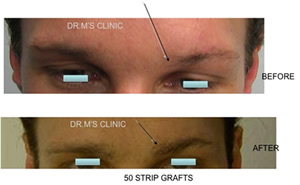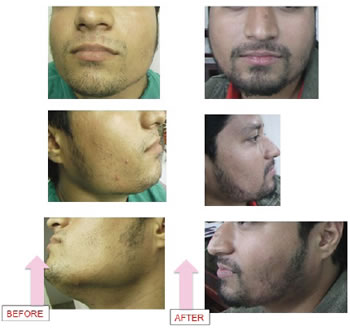|
 |
Eyebrow & Eyelash Hair Restoration Surgery |
 |
|

|
Eyebrows and eyelashes are important for facial symmetry and expression of the face. Eyelashes have an anatomical function of shielding the eye from injury-for example, from dust and grit. Another principal function of eyelashes is ornamental. A person without or disfigured eyebrows and/or eyelashes may feel very self-conscious. |
Eyebrows and eyelashes are lost in a variety of ways:
- Physical trauma—e.g., auto accident, thermal, chemical or electrical burns
- Systemic or local disease that causes loss of eyebrow and/or eyelashes
- Congenital inability to grow eyebrows and/or eyelashes (Congenital atrichia)
- Plucking (to reshape the eyebrow) that results in permanent loss of eyebrows
- Self-inflicted obsessive plucking or eyebrows and/or eyelashes (Trichotillomania)
- Medical or surgical treatments that result in eyebrow or eyelash loss—e.g., radiation therapy, chemotherapy, surgical removal of tumor.
Eyebrows and eyelashes are lost in a variety of ways:
N.B. Trauma, burns or surgery may have resulted in formation of scar tissue; reconstructive surgery may be necessary before eyebrow/eyelash restoration.
Eyebrow Transplantation
There are typical differences compared to the scalp hair transplant:
The direction of eyebrow hair varies in different parts of the forehead. Points in the region of the eyebrow nearest the nose, the hair upwards. The hair on the top of the eyebrow points outward and downward. The hair on the lower part of the forehead is growing outwards and upwards. This growth crisscross pattern makes up the hair in the middle of the eyebrows, forming a fine natural water flows horizontally through the center of each eyebrow. Interlocking ridge that gives eyebrows their fullness
The second feature of the eyebrow hairs that arise from the follicle in a very acute angle, so that the hair grows flat on the surface of the skin. This is in contrast to the head, as the angle between the hair and scalp to 45 degrees. The transplanted hair must be planted to lie as flat to the skin surface as possible. Hairs should be rotated to follow the natural curve of the brow.
The third important feature of the eyebrows is that the hairs grow as individual strands, and not in the 1 - to 4-unit grouping of hair follicles, which are characteristic of her head. Eyebrow transplant is not really Follicular Unit Transplantation, but a sophisticated form of micro-grafting.
The fourth feature of the eyebrow hair is the hair growth cycle is very short. This means that it is) eyebrow (in anagen grow only about 4 months before the rest) (telogen phase and falls out. In contrast, the hair of a growth phase, the last 3 to 7 years can, so that the hair grow longer.
A strip of hair-bearing skin and subcutaneous tissue is removed from a donor area on the scalp and grafted into the surgically prepared eyebrow site. The transplant procedure is performed by selecting a hair-bearing area of scalp with hair that is of appropriate texture and orientation to serve as eyebrow hair. Donor hair for the transplant is taken from a site that furnishes finer rather than coarser hair; finer hair is a better "match" for eyebrow hair. Patient and physician must work together to outline the eyebrow area to conform to the natural symmetry of the patient’s face. Usually 200 to 300 grafts are implanted on one set of female eyebrows, and 300-400 grafts on one set of male eyebrows. Depending on the size of the area to be transplanted, more than one transplant session may be required; two or more sessions several months apart are common. As the transplanted hairs grow in their new position they may require occasional trimming as well as "training" with gel or wax. The transplanted hair continues to grow eyebrows and should be trimmed regularly. Apart from a small annoyance, the trimming of the hair shows a cut-end is not as soft as the fine tip end of a virgin hair.
Postoperative complications are usually limited to minor pain and swelling.
Esthetic Eyelash Transplantation
In some patients with extensive eyelid tissue damage, eyelash transplantation may not be possible until eyelid tissue reconstruction has been successfully performed.
Patients with Congenital atrichia are not candidates for eyelash transplantation, as they have no source of donor hair to use as transplantation grafts; but they are candidates for eyelash prostheses that are fastened to the eyelid with adhesive.
If the disease responsible for hair loss is active, transplantation should not be undertaken. If the disease is in remission, it must remain in remission without recurrence for at least two years is a common requirement.
In patients whose eyelash loss is due to compulsive hair plucking (trichotillomania), eyelash transplantation should not be undertaken until the condition is demonstrably under control.
Eyelash transplantation is not justified, for an individual patient with Body Dysmorphic Disorder (who has no remarkable esthetic deficits to the objective observer, but they feel they do have significant deficits).
Eyelash transplantation is contraindicated in conditions such as aberrant eyelash growth, recurrent entropion , "bulging" eyes due to hyperthyroidism or keratoconus, and recurrent conjunctivitis.
It should be avoided in a patient has a history of keloid or hypertrophic scar formation at sites of surgery or injury.
Preoperative Preparation: 7 days before surgery stop blood thinners like aspirin and warfarin, vitamin E and Stop drinking alcohol. Prophylactic antibiotics are started a day before.
Procedure: When eyelash transplantation is performed for esthetic enhancement, the patient's rationale is usually to gain greater eyelash density (adding eyelashes to the eyelid among existing eyelashes), or eyelash length (grafting hairs into the eyelid that have the capacity to grow longer than existing eyelashes).
Transplantation is the only procedure used to restore eyelash hair. Smaller, finer hairs are best Donor hair for transplantation of eyelash. All grafts are single hairs meticulously placed into the lid. Donor areas commonly used include the nape of the neck or the area of the scalp above or behind the ears.
Grafts are carefully placed for proper spacing and to prevent trichiasis (turning in of the hair against the eyeball). The number of hairs transplanted in each eyelid is sufficient to accomplish the desired result (the normal upper eyelid contains about 100 lashes, the lower eyelid about 60 lashes). Interspersion of a few hairs among existing hairs can appreciably increase the appearance of eyelash density. In reconstructive eyelash surgery, placement of about 20 hairs can create an appearance of normality. Transplantation of as few as 6 hairs in a physically injured, badly scarred eyelid can create an acceptable "natural" appearance. Eyelash transplantation requires at least 25 to 50 hairs per upper lid. A desirable result may be achieved in one, two or three sessions. The transplanted hairs fall out at around 2 weeks, and then start to regrow at 3 months, where they will continue to grow for a lifetime.
Itching is a common and troublesome postoperative complication. Scratching there is risk for dislodging the hair grafts and initiating infection. Itching should be relieved as much as possible by ophthalmic ointments, mild analgesics such as Paracetamol, and ice packs. Eyeglasses may be worn to deter scratching. About 7 to 14 days is required for complete postoperative recovery.
Transplanted lashes will grow outward and away from the eye in the manner of natural lashes; otherwise, they must be "trained" to behave as eyelashes. Typical training includes coating the new eyelashes with lash oil and using an eyelash curler to encourage proper curl. Regular trimming to the desired length typically once a month is also required.
Other problems can be Eyelid infection, Bruising and swelling, Graft displacement, Ingrown hair grafts, Ectropion, Entropion, Trichiasis, Poor placement or poor quality of eyelash grafts that fails to achieve the desired esthetic result. |
|
|
|
| |
 |
Hair Transplant for other areas of Body : Moustache, Beard, Chest, Pubic |
 |
|
 This is a procedure designed to restore hair in other areas to both thicken the existing hair or to provide hair growth where there is none. The absence of hair could be due to genetics, prior electrolysis or laser hair removal, or even trauma due to surgery, burns or other types of accidents. Some patients seek to have restored only a thin amount of coverage or filling in of a limited area (i.e. central chest or pubic triangle), while others desire a thick chest and central abdomen area- for these cases desiring maximum density, a second procedure typically needs. This is a procedure designed to restore hair in other areas to both thicken the existing hair or to provide hair growth where there is none. The absence of hair could be due to genetics, prior electrolysis or laser hair removal, or even trauma due to surgery, burns or other types of accidents. Some patients seek to have restored only a thin amount of coverage or filling in of a limited area (i.e. central chest or pubic triangle), while others desire a thick chest and central abdomen area- for these cases desiring maximum density, a second procedure typically needs.
The donor hairs come from the scalp, which typically grow like normal body hair in their texture and other characteristics, with one exception- they continue to grow as if they were on the scalp, and therefore need to be trimmed typically monthly. Once transplanted, the hairs are permanent. To provide a completely natural appearance, the hairs are transplanted as one and two hair grafts, the natural way body hair grows. Other steps taken to assure naturalness include the careful placement of the grafts at the exact correct angle and direction, placed in the smallest possible incisions so as to minimize scarring, and even the aesthetic distribution of any existing gray hairs into the restored areas. Note that these hairs transplanted into the body are no longer available for transplanting into the scalp if the patient desires to undergo restoration of any male pattern hair loss that may develop in the future, thus meaning that there will be fewer hairs available for this area.
A procedure may involves the placement of 200 to as many as 3400 one and two hair grafts,. For the first 5 days after the procedure, tiny crusts are around each transplanted hair. By the second day, patients are able to return to normal activities. Sutures that are placed in the donor area are dissolvable so there is no need to return to the clinic for removal. The transplanted hairs fall out at around 2 weeks, then start to regrow at 3 months, where they will continue to grow for a lifetime.
There are few risks with the procedure, and most are those associated with standard hair transplants.
|
|
|
|
|